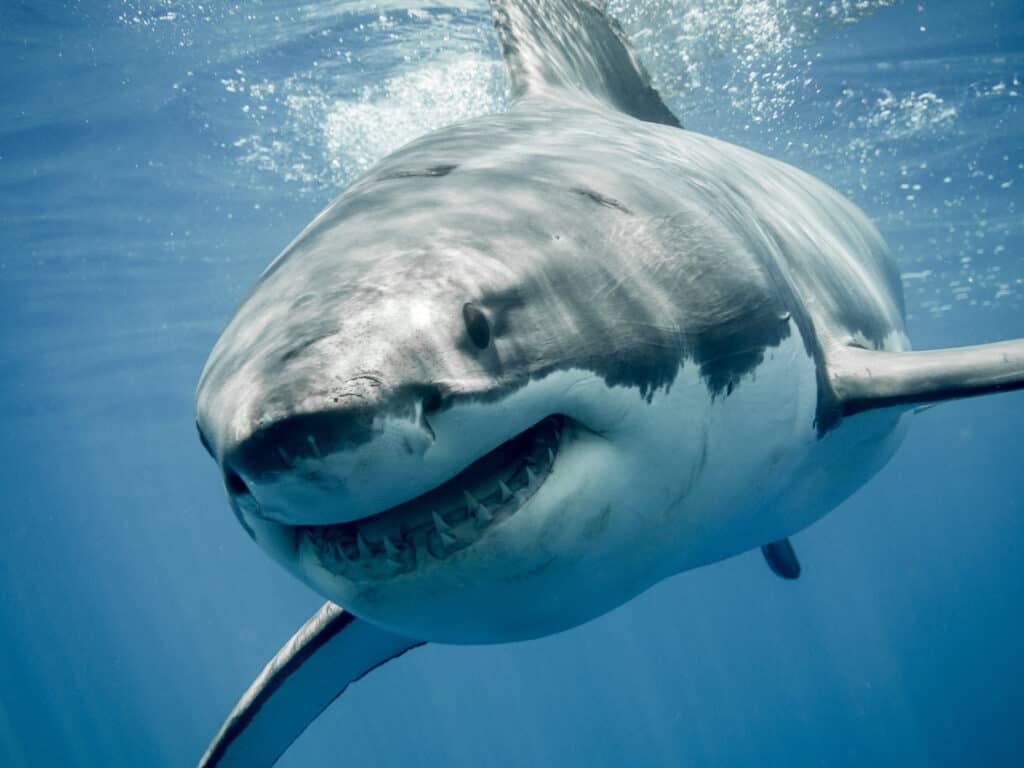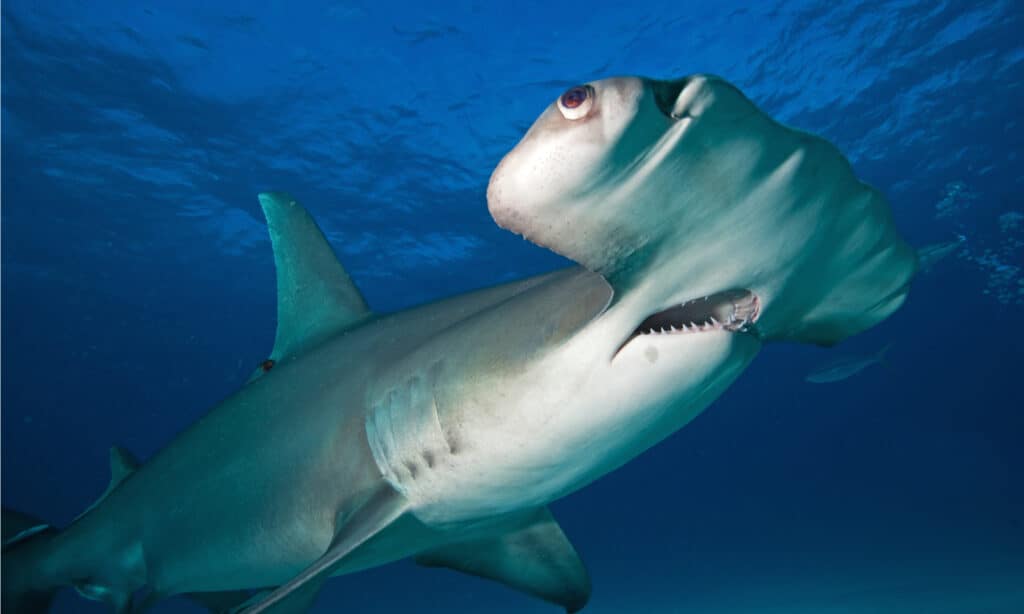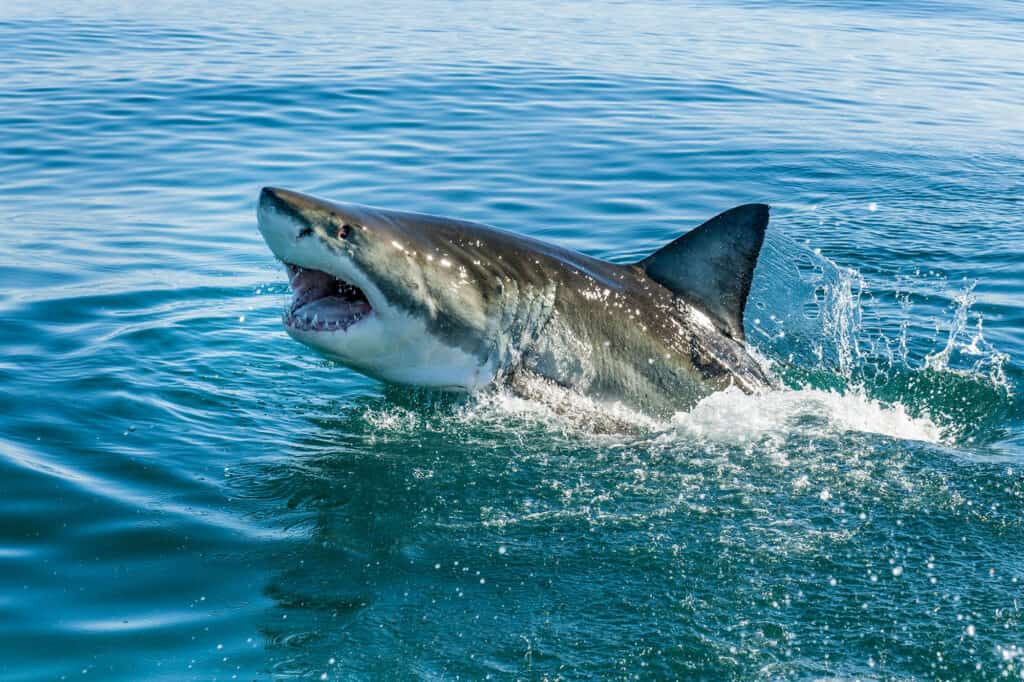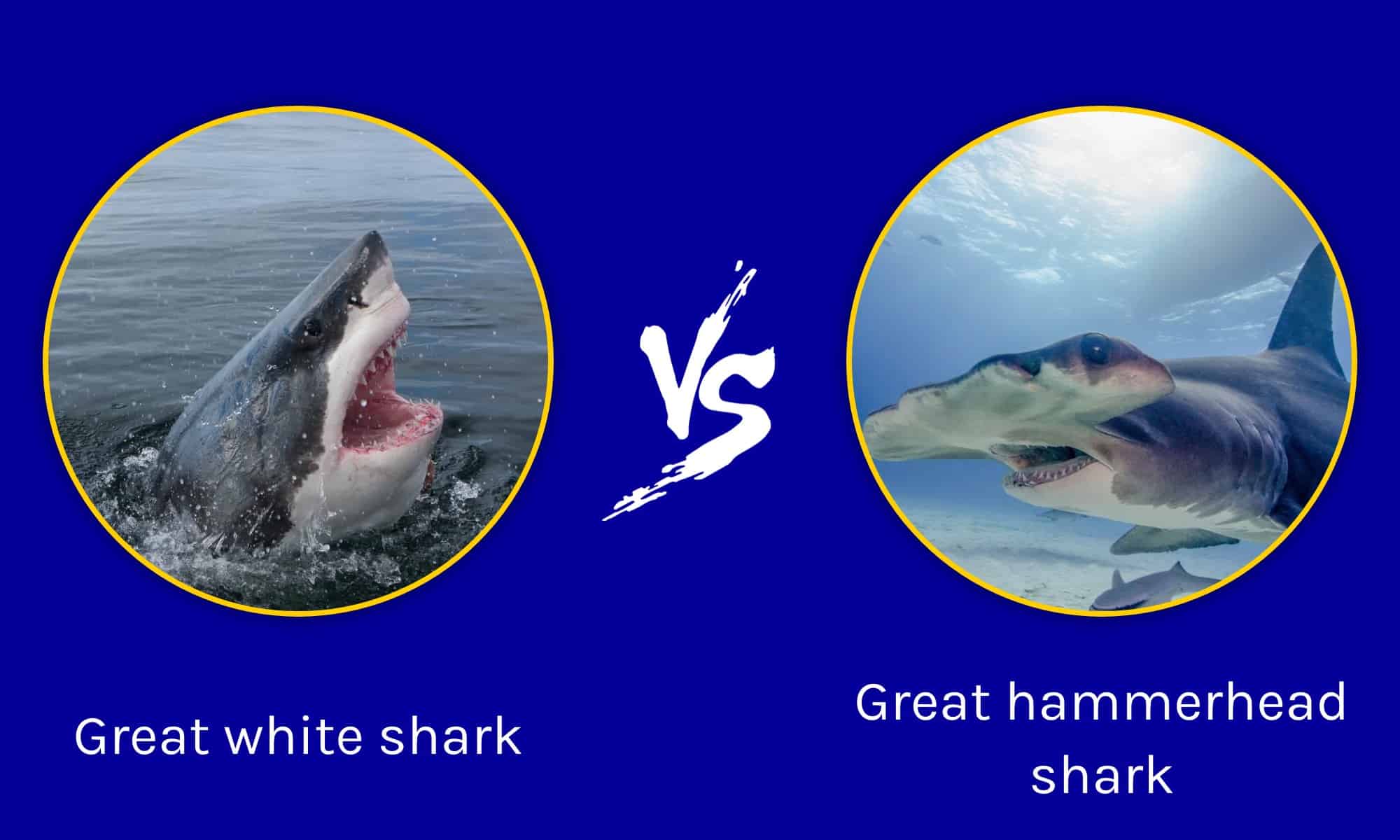Key Points:
- A major difference between these two sharks is their appearance. The great hammerhead shark has a hammer-shaped head, while the great white shark has a pointy snout and streamlined body.
- The two differ in size, with the great white much larger at 18-26 feet long and weighing 2,450-4,938 pounds on average.
- They also vary in habitat preferences, diet, gestation period, litter size, lifespan, and conservation status.
The great hammerhead shark head and the great white shark are shark species known for their “greatness” in size. The great hammerhead shark belongs to the Sphyrnidae family and is scientifically named Sphyrna mokarran, while the great white shark belongs to the Lamnidae family and is known scientifically as Carcharodon carcharias. Both species have tons of other differences and peculiarities and we’ll be exploring some of the most prominent ones below. Stay with us to learn more.
Comparing Great Hammerhead Shark vs. Great White Shark
| Great Hammerhead Shark | Great White Shark | |
|---|---|---|
| Size | Length: 10-14 ft Weight: 900-1,280 lbs | Length: 18-26 ft Weight: 2,450-4,938 lbs |
| Appearance | Hammer-shaped head, triangular teeth with incredibly serrated edges, curved rear margins on the pelvic fins. | Stream-lined bodies, slightly pointed snouts, 300 triangular and highly serrated teeth, onyx-colored eyes, crescent-shaped tails, and dark gray/light gray dorsal sides |
| Location and Habitat | Location: Tropical waters worldwide. Habitat: shallow waters, open ocean, continental, and insular collar reefs. | Location: All cold temperate and tropical coastal waters. Habitat: insular and continental shelves; waters with sea surface temperatures. |
| Diet | Carnivorous; stingrays, smaller sharks, bony fishes, crustaceans, squids, and even octopuses | Carnivorous; seals, sea lions, porpoises, dolphins, and smaller whales. |
| Gestation Period and Litter Size | Period: 11 months Litter size: 6-42 | Period: 12-18 months Litter size: Average of 9 |
| Lifespan | 20-30 years | 30-40 years |
Key Differences Between Great Hammerhead Sharks and Great White Sharks
The major differences between the great hammerhead shark and the great white shark are seen in their size and appearance. We shall examine these as well as other subtle differences and peculiarities to form a comprehensive comparison.
Size

The great white shark measures between 18 and 26 feet in length and has an incredible weight of 2,540-4,938 pounds
©Ramon Carretero/Shutterstock.com
The great hammerhead shark and the great white shark are both large in their own right which is one of the major reasons they both have “Great” prefixes. However, when placed side by side, the great white shark dwarfs the great hammerhead shark as we are about to see.
The great hammerhead shark measures about 10-14 feet in length with a massive weight estimated at 900-1,280 pounds. The great white shark, on the other hand, measures between 18 and 26 feet in length and has an incredibly humongous weight of 2,540-4,938 pounds. These figures show the great white shark is much longer than the great hammerhead shark and is at least three times its weight. In other words, when it comes to overall size, the great white shark wins by every metric and the difference is quite massive.
Appearance

Great
hammerhead sharks
have triangular teeth with serrated edges, and concave rear margins on the pelvic fins.
©Martin Prochazkacz/Shutterstock.com
The great hammerhead shark and the great white shark also differ to a great degree in physical appearance. For starters, the great hammerhead shark has a hammer-shaped head, like its name implies, as well as triangular teeth with serrated edges, and concave rear margins on the pelvic fins.
The great white shark, for one, does not have a hammer-shaped head like the great hammerhead shark. It, however, has a streamlined body, onyx-colored eyes, pointy snouts, crescent-shaped tails, and triangular/serrated teeth. The shark also has dorsal sides with colors ranging from light gray to dark gray.
Location and Habitat
The great hammerhead shark and the great white shark can both be found in oceans around the world. However, there are some slight variations in habitat preferences. Starting off with the great hammerhead shark, they are found in tropical waters globally, particularly in shallow coastal waters. They have been observed to migrate northwards during summer.
The great white shark also has a presence in all cold, temperate, and tropical coastal waters. They are particularly present in coastal waters off western South Africa and central California. There are also reports of great white sharks in North American coastal waters stretching from Florida to Alaska to South Mexico. Great white sharks love insular and continental shelves most probably because they are good hunting grounds. They are also known to prefer ocean surface temperatures.
Diet

Great white sharks include sea lions, seals, and dolphins in their diet.
©iStock.com/ELizabethHoffmann
As you can probably guess, the great hammerhead shark and the great white shark are strictly carnivores. And while both animals settle for sea creatures, there are some differences. Great hammerhead sharks have a diet comprising stingrays, bony fishes, small sharks, crustaceans, squids, and the like. Great white sharks, on the other hand, prefer larger marine mammals like sea lions, seals, dolphins, small whales, and porpoises.
What this means is great white sharks have a larger diet and go for bigger animals, which is pretty understandable, given their size.
Gestation Period and Litter Size
Great hammerhead sharks and great white sharks have some variations in production, in that while the former is viviparous, the latter is ovoviviparous. What this means is while great hammerhead sharks give birth directly without any hatching needs, great white sharks have eggs develop and hatch inside their mother’s bodies who will then give birth to the young.
Besides that, there are also differences in gestation period and litter size. The great hammerhead shark has a gestation period of about 11 months and a litter size of between six and 42 pups. The great white shark, however, has an incubation period of 12-18 months and a much smaller litter size ranging between two and 14 pups, with an average of 9 pups.
Lifespan
The great hammerhead shark and the great white shark also differ in terms of lifespan with the latter expected to live much longer. The great hammerhead shark has a life expectancy of 20-30 years while the great white shark boasts 30-40 years in expected lifespan.
Conservation Status
The great hammerhead shark and the great white shark also differ in terms of conservation status. The IUCN lists the great hammerhead shark as “critically endangered” due to declining populations. Meanwhile, the great white shark is listed as “vulnerable” which means while the species’ existence is considered threatened, it is not in as much danger as the great hammerhead shark — at least, not yet.
Thank you for reading! Have some feedback for us? Contact the AZ Animals editorial team.








